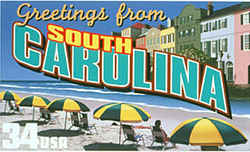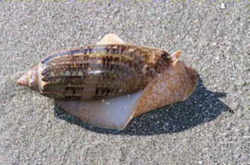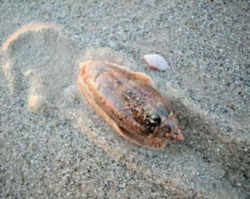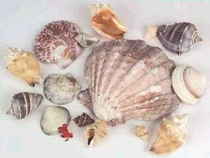
South Carolina Symbols
South Carolina State Shell
Lettered Olive

(Oliva sayana)
Adopted in 1984.
The Lettered Olive, (Oliva sayana,) was designated the official shell of the State by Act No. 360, 1984.
Dr. Edmund Ravenel of Charleston, South Carolina, an early pioneer in concholgy, found and named the Lettered Olive shell which is quite prolific along the South Carolina Coast.
South Carolina State Shell: Lettered Olive

Shells of the family Olividae tend to be cylindrical,
smooth and shiny, and variously patterned with numerous fine wrinkles. The lettered olive is an attractive cream or tan colored shell with 5 or 6 whorls
and distinct suturing. The spire is fairly low; the aperture is long, smooth, and without teeth; and, the columella shows folds. Like many gastropods,
these molluscs maintain a highly polished shell, by pulling their mantle flaps over the exposed surface. Many specimens have purple zigzag patterns
and purple outer lips. Olives are approximately 66mm in length and 20mm wide.
All members of the Olividae family are carnivorous sand-burrowers. Although in a different superfamily than the Muricidae, the Olividae secrete a similar
mucus from which a purple dye can be made (Monfils, 2001) They are distributed in warm and tropical seas.
South Carolina State by Act No. 360, 1984.
(A360, R410, S735)
AN ACT
TO AMEND THE CODE OF LAWS OF SOUTH CAROLINA, 1976, BY ADDING SECTIONS 1-1-680, 1-1-690, AND 1-1-695, SO AS TO PROMOTE THE AGRICULTURAL INDUSTRY OF
SOUTH CAROLINA BY DESIGNATING THE PEACH AS THE OFFICIAL FRUIT OF THE STATE, MILK AS THE OFFICIAL STATE BEVERAGE, AND THE LETTERED OLIVE AS THE OFFICIAL
STATE SEASHELL.
Be it enacted by the General Assembly of the State of South Carolina:
Findings
SECTION 1. The General Assembly finds that:
(1) South Carolina is the nation's leading peach producer and shipper east of the Mississippi River producing, in 1981, the largest crop ever - over
four hundred thirty million pounds, worth over sixty-two million dollars;
(2) Statistically reported as "the Nation's Fresh Peach State in Interstate Shipments", South Carolina in 1981 packed and shipped three hundred
ninety-three million pounds of peaches;
(3) Several large in-state markets have enabled South Carolina to earn the distinction of shipping more peaches out of state than any other state;
(4) Peach production forecasts indicate that by 1985 South Carolina will produce more fresh peaches than any other state in the nation, which will
give a tremendous boost to the state's economy.
Peach declared official fruit
SECTION 2. The 1976 Code is amended by adding:
"Section 1-1-680. The peach is the official fruit of the State."
Findings
SECTION 3. The General Assembly finds that:
(1) The use of milk and milk products is the best way to provide a healthy but varied diet;
(2) Over twenty percent of the nation's protein is supplied by dairy products;
(3) Seventy-two percent of all the nation's calcium comes from dairy products;
(4) Dairy farmers are found in every county of this State except seven;
(5) Nearly fifty thousand cows produce nearly five hundred seventy million pounds of milk annually in the State with a gross volume alone of over eighty-nine
million sixty-two thousand dollars;
(6) The dairy industry in this State represents a one hundred million dollar enterprise.
Milk declared official beverage
SECTION 4. The 1976 Code is amended by adding:
"Section 1-1-690. Milk is the official state beverage."
Findings
SECTION 5. The General Assembly finds that:
(1) South Carolina's coastal area is one of the most widely promoted areas in the State for recreation and tourism.
(2) Shelling along the beaches of South Carolina is becoming increasingly popular among residents as well as with the tourist trade. It is a form of
recreation which can be enjoyed by a wide spectrum of the population.
(3) The Lettered Olive shell is quite prolific along the South Carolina coast and will make the finding of the shell more meaningful for South Carolinians,
tourists, and shell collectors.
(4) The Lettered Olive was found and named by a South Carolinian, Dr. Edmund Ravenel of Charleston, who was an early pioneer in conchology. This name
was given to this shell because of its hieroglyphic type markings.
Lettered olive declared official shell
SECTION 6. The 1976 Code is amended by adding:
"Section 1-1-695. The Lettered Olive, Oliva sayana, is the official shell of the State."
Time effective
SECTION 7. This act shall take effect upon approval by the Governor.
The South Carolina Law
The law designating the Lettered Olive, as the official South Carolina state shell is found in the South Carolina Code of Laws, Title 1, Chapter 1, Article 9, Section 1-1-695.
Title 1 - Administration of the Government
CHAPTER 1. GENERAL PROVISIONS
ARTICLE 9. STATE EMBLEMS, PLEDGE TO STATE FLAG, OFFICIAL OBSERVANCES
SECTION 1-1-695.
SECTION 1-1-695. Official State shell.
The Lettered Olive, Oliva sayana, is the official shell of the State.
Taxonomic Hierarchy: Lettered Olive
Kingdom: Animalia - animals
Phylum: Molluscs
Class: Gastropoda
Subclass: Prosobranchia
Order: Caenogastropoda
Superfamily: Volutacea
Family: Olividae
Genus: Oliva
Species: Oliva Sayana







